The post Announcing Web Push Notifications on B.O.S appeared first on NEAR Protocol.
]]>Apps and components built on the NEAR B.O.S have always benefited from in-site notifications to keep their users informed about relevant updates. Until now, these notifications were only shown within near.org (and other compatible gateways), meaning that users had to visit the website to see them. Now, users can opt-in to receive push notifications directly on their computers and phones about important events in their favorite apps. This way, users can be notified in real time, even if they are not actively navigating near.org.
Why are push notifications useful?
Thanks to push notifications, users can receive timely updates and information about their account’s activities in real time and through multiple channels. The increase in awareness also benefits application developers by encouraging users to return to the app, thus significantly improving user engagement. This way, push notifications help to tackle one of the biggest problems for founders in Web3: re-engaging and retaining users. Nowadays, user retention rates in Web3 fall short of the industry standard for web apps, which stands at a 35% retention rate after 30 days. Thanks to web push notifications, developers on BOS now benefit from a powerful new tool to re-engage their user base.
What will the notification experience look like on near.org?
On near.org, users will be asked to opt-in to the new push notification system on their desktop and iOS/Android mobile browsers. (To enable browser push notifications on iOS, users need to update their device at least to iOS 16.4 and will also need to add the near.org website as an app icon to their home screen – see link.) If the user accepts, they will automatically start to receive notifications for baseline social activities on their account. Users will be able to view all notifications in the notification center, and set their notification preferences via the designated settings menu.
For developers implementing components and apps, the new notification system is completely transparent. Apps that already leverage the in-site notification system will automatically benefit from web push notifications, meaning their users will also be notified on their desktop and mobile in real time.
For gateway developers, Pagoda is releasing a comprehensive guide on how to add web push notifications using a simple web service.
What are some examples of notifications I could add to my application?
Notifications can apply to any event that developers want to inform users about. Some examples of how developers have used these are:
- Notify updates on the status of a bid placed on an NFT marketplace.
- Tell users that they gained a new follower.
- Inform of a reply to a comment on a discussion.
- Any other on-chain action that is sent to the current notification system.
How do I learn more and get started?
The best place to start is by checking the official documentation. You can also check examples of apps sending notifications such as the LikeButton and FollowButton. If you have any questions or need to reach out to the Pagoda product team, remember that we have weekly office hours, and an active Telegram channel where members of the community can help you.
What’s coming next?
Stay tuned! Pagoda plans to release additional notification features later this year, including support for more granular notification settings and safeguards to manage notification volume for users on near.org. They will also be exploring support for near.org notifications via email.
The post Announcing Web Push Notifications on B.O.S appeared first on NEAR Protocol.
]]>The post Mantle Ecosystem Gateway Launches on the NEAR Blockchain Operating System (B.O.S) appeared first on NEAR Protocol.
]]>Hosted by popular Mantle dApp FusionX, the gateway, built in collaboration with the NEAR community, streamlines the discovery of Mantle applications and helps aggregate components of top dApps including the Mantle Bridge, Agni, Ammos, iZiSwap, FusionX, Gamma, Lendle, and soon Pendle, in one place.
The gateway offers greater accessibility for developers and users, easier discoverability for the apps they build, and powerful composability. This was all made possible thanks to the B.O.S.
“Mantle has seen some great traction since their launch and we’re very excited to have a Mantle gateway built on B.O.S. Ethereum and DeFi users interested in discovering new projects can now find lots of Mantle apps in one place, with bridging already solved so they can get started right away,” says Illia Polosukhin, co-founder of NEAR Protocol. “The Mantle gateway demonstrates the value of B.O.S gateways for other L2s and EVM projects looking to increase discoverability.”
Unlocking the Web3 ecosystem
Mantle’s development on NEAR is a testament to the protocol’s commitment to creating the foundations for the open web. “We are delighted to ally with NEAR in bringing leading Mantle dApps to a wider community through the Mantle Ecosystem Gateway on B.O.S,” says Arjun Kalsy, head of ecosystem of Mantle. “Through this effort, we look to provide even more support to our dev community, and allow for more cross-pollination in our respective Web3 communities.”
The Mantle gateway joins a growing list of projects that have partnered with the B.O.S to help unlock the full potential of Web3. A zkEVM B.O.S gateway for the Polygon ecosystem launched on NEAR to help increase accessibility and discoverability for developers, while also improving the user experience for end users exploring L2 ecosystems.
While the B.O.S is built on NEAR, it offers many benefits to founders and builders from EVM projects and across the whole Web3 ecosystem. The Blockchain Operating System speeds up the process of building multi-chain experiences, empowering builders from any ecosystem––including EVM projects such as Ethereum layer 2s––to focus on creating great products for users rather than on managing infrastructure.
Developers can quickly build composable apps for the open web from thousands of flexible components, as well as seamlessly onboard users and increase discoverability across Web3 since every application utilising B.O.S is visible on a common interface. This collaboration brings new capabilities to developers and lets them build apps that can quickly reach more users.
The post Mantle Ecosystem Gateway Launches on the NEAR Blockchain Operating System (B.O.S) appeared first on NEAR Protocol.
]]>The post ICYMI: Scootering Through Web3 at NEAR APAC’s Vietnam Showcase appeared first on NEAR Protocol.
]]>The event was spearheaded by the NEAR Vietnam Hub with support from the NEAR Foundation, exemplifying strong commitment and collaboration between local and global ecosystem stakeholders. ICYMI, here are some of the biggest sessions, announcements, and events from NEAR APAC 2023.
ICYMI, here are some of the biggest sessions, announcements, and events from NEAR APAC 2023.
Web3’s bright investment outlook in Asia-Pacific
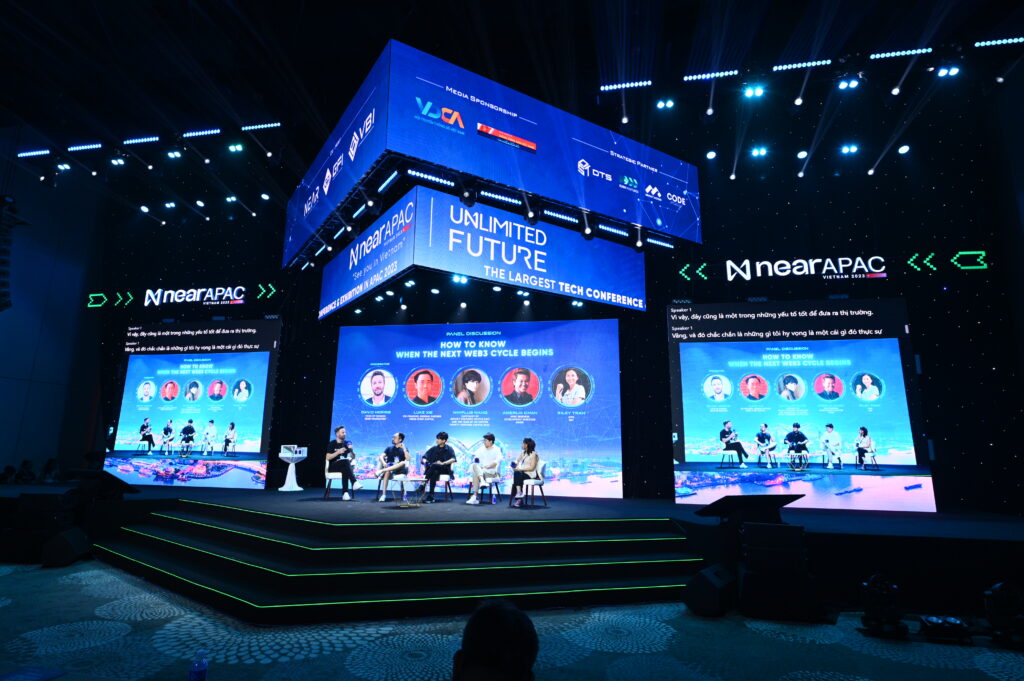
One of the most encouraging and optimistic sessions was moderated by NEAR’s Head of Finance, David Norris, focusing on the current and future outlook of blockchain investment and development in the region. David was joined by Web3 venture veterans Riccardo Pagano from Outlier Ventures and Whiplus Wang of IVC crypto.
The trio dove into the current state of blockchain investment in APAC, and how Web3 might just ascend to becoming one of the most invested sectors in the region from a venture and infrastructure perspective. Ricardo in particular emphasized that he’s seeing a shift in perception from investors, with Web3 going from a niche technology to its own broad-based sector.
“Even though we’re technically in a bear market, investment in Web3 sub-sectors like gaming is still strong,” added Whiplus. “Games like Angry Birds and Fruit Ninja were instrumental in onboarding Web2 users onto the smartphone, for example. That’s why investment into blockchain game publishers is increasing — to find that killer game that onboards billions.”
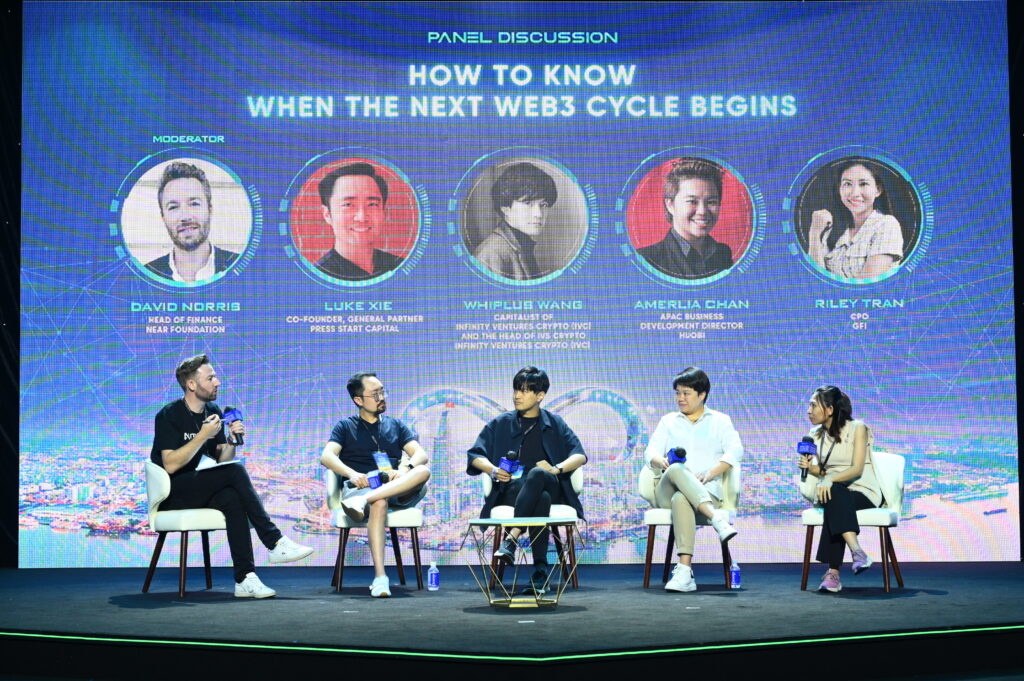
Whiplus also likened successful blockchain startups to a bowl of Pho, with a blend of technical and business elements being integral to a delicious final dish. The panel also touched on technical nuances like ZK rollups and modular blockchains, emphasizing the need to invest in talent and innovation through initiatives like hackathons.
The session encapsulated a forward-looking perspective on Web3’s trajectory. With the bar for founder participation evidently rising, the panel stressed the importance of education in the space. There was unanimous optimism about Southeast Asia’s digital future as potentially outpacing even established tech hubs like Korea and Japan.
NEAR supports B.O.S. and blockchain builders in APAC
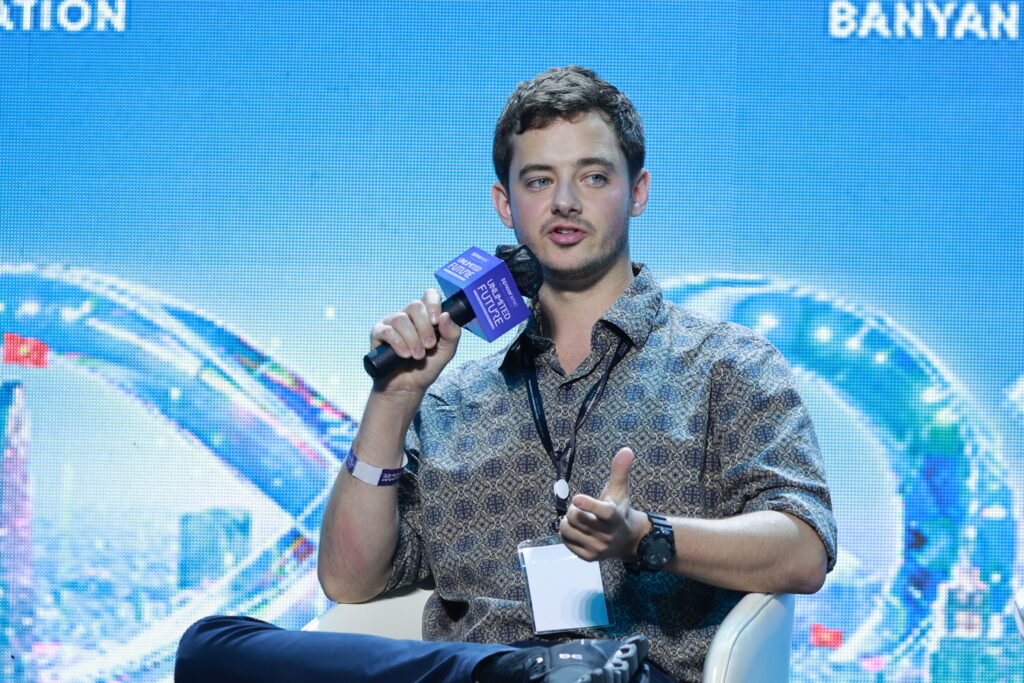
Tons of activity also took place in and around the Builder Stage, with the NEAR Foundation and local blockchain organizations teaming up to educate and assist developers, builders, and job seekers in advancing themselves into Web3. Cameron Dennis, CEO of Banyan, led a panel on the stage informing developers on how to upskill from Web2 to Web3.
Local developer advocates from notable projects like the Graph and Khyber network also participated in sessions, workshops, and panels on the Builder Stage designed to upskill local blockchain professionals. There was something for everyone, from a job fair for Web3 newbies to a Greenhouse area connecting founders and projects to VCs for funding.
Exploring everything from dApp architecture to tokenomics, the Builder Stage action was highlighted by an incredible Hackathon, with participants receiving guidance from experts like Oleg Fomenko, founder of SWEAT. On the final night of the festivities, NEAR co-founder Illia Polosukhin presented awards to the winners on stage in front of a packed main hall.
Pagoda takes the main stage to talk user adoption and FastAuth
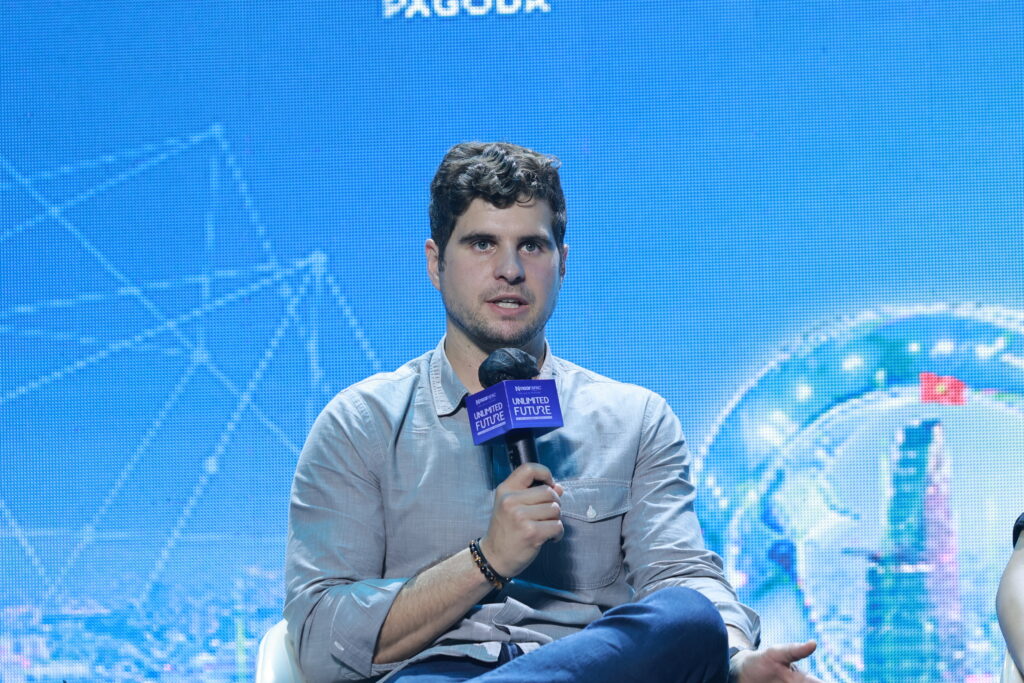
Alex Chiocchi, the CPO of Pagoda, showcased FastAuth during his session titled “Unlocking the Power of B.O.S: Product Update for Founders & Developers.” FastAuth aims to redefine the user experience for developers and founders, addressing the longstanding challenges of both onboarding and retaining new Web3 users.
A primary takeaway was how FastAuth’s next release will minimize gas fees when onboarding, thus removing barriers for end-users. The introduction of multiparty compute (MPC) allows proofs from various organizations to be combined, simplifying processes like email recovery. Chiocchi emphasized the potential for users to migrate effortlessly from Web2 logins, hinting at a seamless integration between the two web generations.
Discussing the nuances of retaining users in Web3, Chiocchi stressed that coin incentives alone aren’t sufficient. The “toothbrush test” was highlighted, illustrating that many apps don’t become daily necessities for users. Trust plays a pivotal role, especially with the rise of scams in the decentralized space.
Side events and after-parties storm the streets of Saigon

NEAR APAC fully embraced the “work hard, play hard” ethos of Vietnam and Asia-Pacific. Even during the event, there were LED dancers, Manga Cosplay, and several massive DJs and party breaks. Not to mention the NEAR APAC Opening Night party at the Intercontinental Hotel, where Illia officially welcomed attendees and kicked things off in an intimate setting.
And in one of the coolest side events in recent NEAR memory, Dap Dap showcased its platform to B.O.S. enthusiasts at the My House meeting venue nestled in one of Saigon’s many cozily-lit alleyways. Dap Dap is the first commercial B.O.S. product and will act as a gateway to hundreds of chains and protocols for users from a single, user-friendly interface.
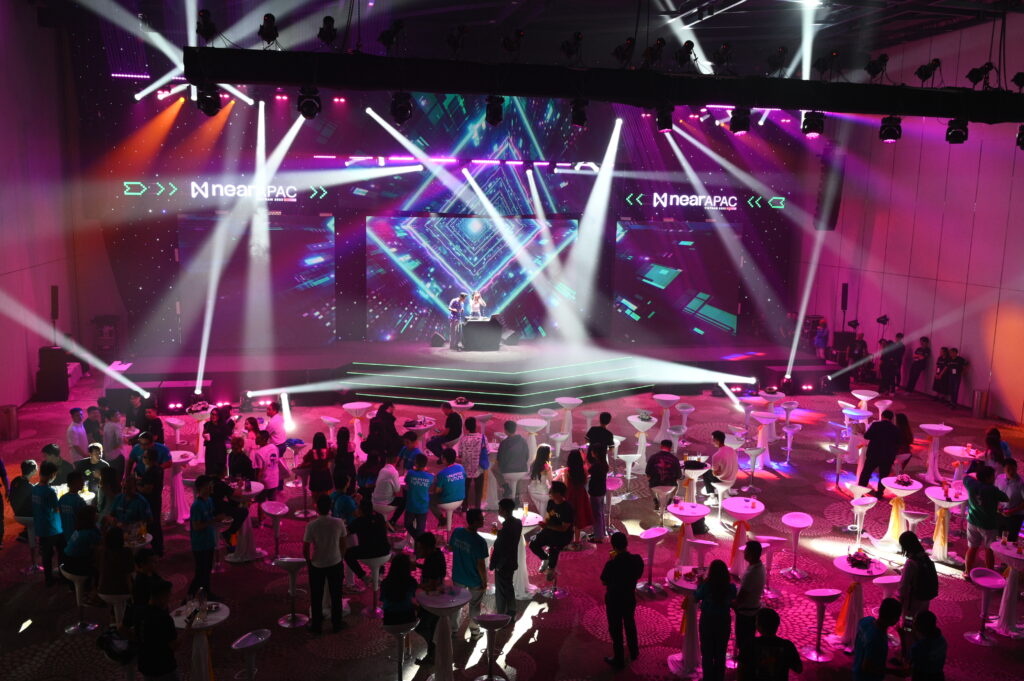
B.O.S Beats by DAO Records was the grand finale of NEAR APAC, offering a vibrant blend of hip-hop beats from prominent DJs on the decentralized record label. Held at Indika Saigon — and with pizza supplied by Pizza DAO — attendees enjoyed live performances, refreshments, and networking opportunities with the global and APAC NEAR communities.
NEAR APAC was an incredible Web3 Bánh Mì, layering an eclectic mix of speakers, insights, and events to create something completely unique. The NEAR Foundation would like to thank every cook in the kitchen, especially local partners like the NEAR Vietnam Hub who made sure that the first ever NEAR APAC had the perfect mix of sweet, sour, and spicy.
The post ICYMI: Scootering Through Web3 at NEAR APAC’s Vietnam Showcase appeared first on NEAR Protocol.
]]>The post Case Study: Building on the NEAR Blockchain Operating System (BOS) appeared first on NEAR Protocol.
]]>In the latest NEAR Foundation Case Study video, viewers take a deep dive into the Blockchain Operating System (BOS). We explore how the BOS, like a decentralized app store, isn’t controlled by any centralized entities. Other topics of conversation include BOS Gateways, the discoverability and composability of BOS apps and components, building on the BOS with Javascript, and integrations with Visual Studio Code and Github.
The post Case Study: Building on the NEAR Blockchain Operating System (BOS) appeared first on NEAR Protocol.
]]>The post Get to Know the BOS: FastAuth for Easy, Web2 Style Onboarding and Account Recovery appeared first on NEAR Protocol.
]]>With FastAuth, BOS users get a better than Web2-style onboarding experience, allowing them to easily create an account for any app on the BOS without a new password or the need to buy any crypto. And perhaps most powerfully for developers, FastAuth is both the easiest and fastest way to get people to try their new components and apps, yet another reason why developers will want to build on the BOS. This helps dramatically lower the threshold for adoption and opens the door to bringing billions of Web2 users into the Web3 space.
To get up to speed on FastAuth, here is a FastAuth primer with some product demo videos.
Easy onboarding and email recovery with FastAuth
FastAuth gives users the power to quickly and easily create a single account that can be used for any website or app that integrates with the Blockchain Operating System (BOS). This feature makes FastAuth an ideal tool for developers building components on NEAR.
With a Web2-style onboarding experience that puts the user experience front and center, users can create a free account using biometrics, phone prompts, and an email address. This means that users can quickly interact with an app but also easily re-authenticate to the app using the same or different devices.
Since most users are accustomed to centralized authentication methods like “Sign in with Google”, Web3 account management using seed phrases and wallets have, until now, created a significant barrier to entry for many people. By combining FastAuth with decentralized email recovery, users no longer need to remember seed phrases or install third party wallet applications. Users can recover their accounts through a “Single Sign-on” (SSO) process with the email they used at registration.
Account recovery is also decentralized and does not give custodial access to full access keys to any single custodian. It is accomplished through a process called “multi-party computation”. This finally paves a way for mass adoption with an easy, secure, and decentralized account recovery system.
With FastAuth, one of the most challenging parts in onboarding users to Web3 no longer exists. Now, users can set up a BOS account quicker than creating a Gmail, Facebook, Tiktok, or Instagram account. And developers can deliver their Web3 components, apps, and experiences more seamlessly than ever.
No third-party applications required
FastAuth also removes the need to download any third-party applications. Everything just works seamlessly right from the browser on your desktop or mobile device.
By creating an easy, user-centric experience, FastAuth makes the open web accessible to everyone right from the get-go and opens the door to mainstream adoption. Anyone developing components on the BOS can leverage this user-friendly experience to quickly and intuitively get their apps in front of users.
Create an account without crypto
BOS FastAuth has another great trick up its sleeve. Until now, getting started in Web3 and interacting with apps meant acquiring crypto first.
With FastAuth, new users can get started right away without having to buy or be gifted crypto. This is a game changer for developers, enterprises, and end-users alike. Through FastAuth’s use of NEAR’s Meta Transactions and Zero Balance Accounts, users can register an account free of charge. Developers can also use this to their advantage as Meta Transactions paired with relayers, which allow them to sponsor initial interactions for new users without needing to purchase $NEAR.
This streamlined onboarding experience allows developers to significantly increase conversion rates for people trying their components and apps for the first time. FastAuth also expands an app and website’s audience by making it more accessible to mainstream users.
FastAuth creates an easy way for enterprises to integrate Web3 and crypto technology into their business. With just a few lines of code, they can onboard existing users into powerful new community and commerce experiences that are accessible, highly secure , and decentralized.
End users can also get started using Web3 apps and experiences in an easy, accessible way. Setting up a secure fully user-owned account now only takes seconds.
What’s next for FastAuth
While FastAuth is already enabling fast and simple onboarding of mainstream users as well as streamlining component-building for developers on the BOS, a number of other features and upgrades are already in the works:
- The ability to extend relayers and FastAuth to additional gateways beyond near.org
- Further MPC decentralization
- Multi-chain compatibility
- Two-factor authentication
Stay tuned to near.org for new FastAuth features and upgrades, as they are rolled out.
The post Get to Know the BOS: FastAuth for Easy, Web2 Style Onboarding and Account Recovery appeared first on NEAR Protocol.
]]>The post NEAR Blockchain Operating System is Now Live on Near.org appeared first on NEAR Protocol.
]]>A real alternative to the Operating Systems of centralized platforms, the BOS is now live at near.org. As a blockchain operating system for an open web, the BOS is accessible to everyone, not just web3 natives. And it makes Web3 and Web2 easier than ever to access and navigate for users and developers alike.
With the BOS, you no longer have to choose between decentralization and discoverability. Devs and users get the best of both worlds, whether they are new to Web3 experiences and want to play around, or developers looking to build an open web.
Seamless Web2 style onboarding for Web3
When entering Web3, users want an easy Web2-style onboarding experience. Until the BOS, this just wasn’t possible.
With FastAuth, BOS users get to experience a simple and seamless Web2 style onboarding. Users can get started quickly by creating an account for any app on the BOS — without the need for crypto.
By putting the user experience at the center, FastAuth creates a familiar style of onboarding experience, in which users can create a free account with biometrics, phone prompts, and an email address. Users can now quickly interact with an app without having to remember long seed phrases and other difficult passwords.
This will help dramatically move Web2 users into the Web3 space with ease.
Developers are empowered to start and build quickly
The BOS isn’t just built for Web3 natives. It’s designed for any developer interested in open-source and decentralization.
To make Web3 app development fast and easy, the BOS offers a comprehensive set of tools and capabilities to get developers started quickly. These developer enablement tools and capabilities make it possible for developers to quickly build composable apps for the open web, as well as build complete projects using current workflows, seamlessly onboard users, get feedback from real users, and increase discoverability.
From Day 1, any developer can start building on the BOS, making Web3 a more accessible space for all.
Making Web3 search as intuitive as Web2
Finding things in Web3 isn’t always easy. While decentralization is a core attraction to Web3, this very same benefit can make it hard to discover everything that Web3 has to offer.
The NEAR Blockchain Operating System fixes this problem with a comprehensive search experience. On the BOS, users can now quickly find all of the apps and components for building on Web3, as well as connect to people and communities.
BOS users can quickly discover apps, components, and reference documents with an integrated search bar, filtering, and sorting panels. Comprehensive search and discovery also benefits developers, entrepreneurs, and projects across the BOS by exposing their work to a large audience.
Add and maintain new app experiences with BOS gateways
The BOS also features gateways — access points to Web3 apps that pull front-end code directly from the NEAR blockchain and render it for their users.
Gateways assume a variety of forms, from wallets and portfolio management tools to popular single-use applications — like, SWEAT — that want to add additional functionality. Gateways help with simple tasks, like adding swap functionality, all the way up to creating decentralized app stores, and much more. This functionality is available by simply adding a JS library, then choosing which app front-ends you want to include.
Typically in Web3, developers spend a lot of time building and getting their apps discovered. During this process, users often need to switch between multiple platforms to discover apps and experiences. Gateways help to overcome this by making it possible to meet users where they already are, while giving them a broader range of apps and experiences.
Govern your Web3 experience with a content moderation framework
Traditional content moderation processes — seen most notably in Web2 social network apps— are centralized and often lack transparency, making them ill-equipped to meet the demands of content that is potentially offensive, risky, or illegal. With the growing influence of Web3 platforms the need for an innovative solution that addresses these challenges is more critical than ever.
The BOS features a scalable, open source content moderation system. With these BOS features, users can govern their own online experience.
The moderation framework leverages the power of the BOS to tackle the many challenges of managing User Generated Content (UGC) through community engagement and automation, providing a scalable, transparent solution to content review that is easy to use and legally compliant.
With a decentralized approach and community-driven governance and moderation, the BOS’s moderation framework is poised to redefine content moderation for Web3 platforms and contribute significantly to a healthier online environment for all stakeholders.
Build and discover apps on NEAR: the Blockchain Operating System for an Open Web
Whether you’re a Web3 developer, founder, end user, or someone just looking to get into crypto, the NEAR Blockchain Operating System is your easy entry point into the Open Web.
Experiencing the BOS is as easy as visiting Near.org. Let’s build an open web!
The post NEAR Blockchain Operating System is Now Live on Near.org appeared first on NEAR Protocol.
]]>The post Near at ETHDenver: the Blockchain Operating System, Near Day, and More appeared first on NEAR Protocol.
]]>Let’s take a look at all that was Near at ETHDenver.
Near Day talks
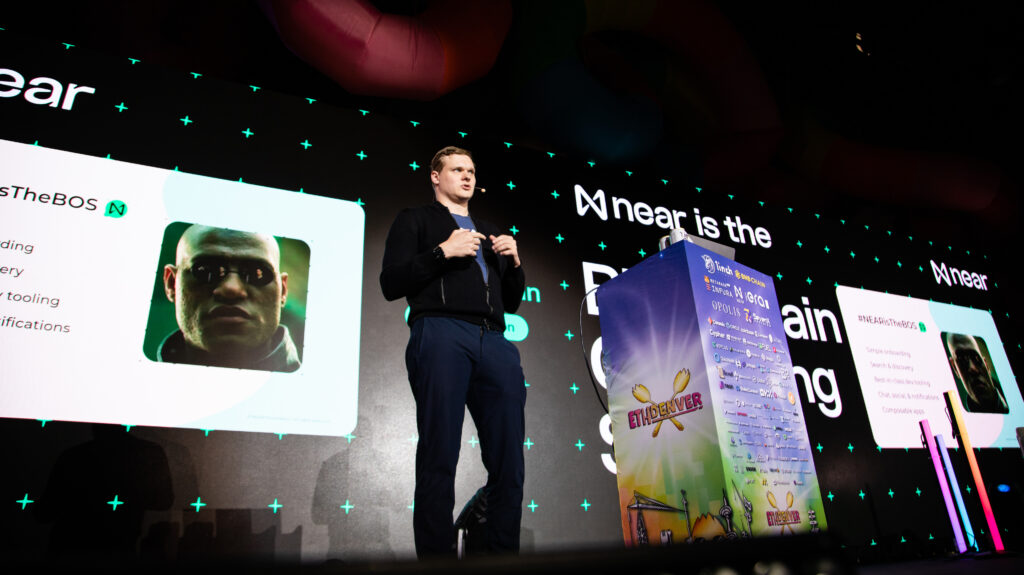
Near Day, the 1-day mini summit on all things Near, was jam-packed with the latest technological and protocol updates. Chief among them was the announcement of the Blockchain Operating System.
Things got started with a Regenerative Finance (ReFI) talk from Open Forest Protocol’s Frederic Fournier and Flow Carbon’s Phil Fogel. Later in the morning programme, OnMachina’s Polina Aladina and Mark Collier talked about building decentralized storage on Near. As a vital Near ecosystem project, it was great for the ETHDenver crowd to hear from OnMachina on Web3 storage.
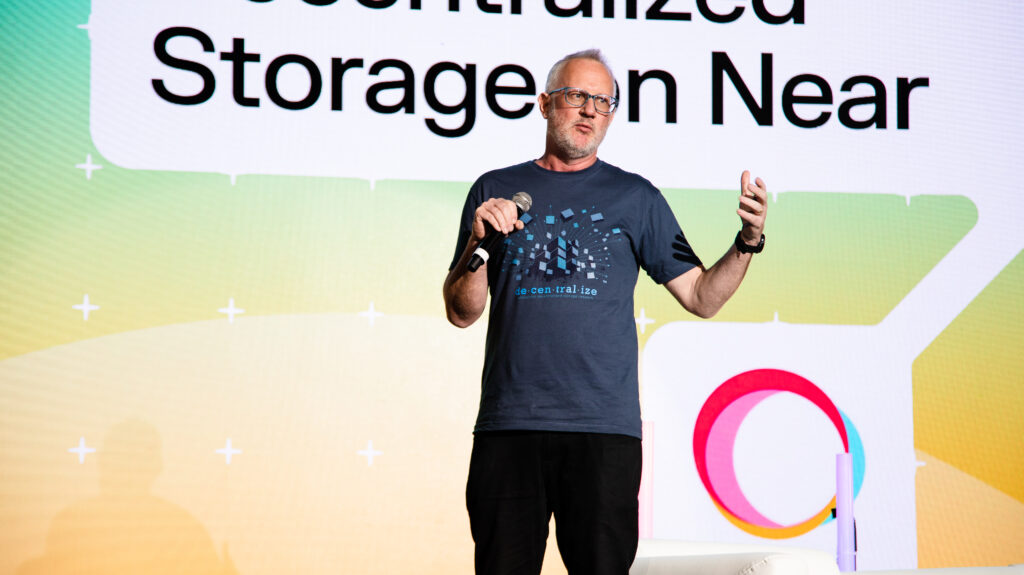
Keypom, which also recently launched on Near, got some much needed visibility at Near Day. In “Instant Crypto Experiences with Keypom”, Ben Kurrek and Matt Lockyer took the audience on a tour of their Web3 onboarding solution, in which users are given a special type of access key that can be used to experience a crypto application and later be turned into a wallet. (Read more about Keypom here.)
The morning programme also featured talks from Calimero Network’s Sandi Fatic on privacy and scaling with private sharding; Aurora Labs’ Alex Shevchenko on Containers, Aurora’s cloud computing solution for blockchains; Sweat Economy’s Oleg Fomenko on how to effectively onboard people from Web2 to Web3; and Near co-founder Alex Skidanov on how the future of AI will be decentralized.
In the afternoon, there were a range of talks, starting with Pagoda’s Max Zavershynskyi presentation on creating “high velocity developer communities” via Near DevGov DAO. But the big news on Near Day was the Blockchain Operating System talk from Near co-founder Illia Polosukhin. After Illia primed the audience, Pagoda’s Chief Product Officer Alex Chiocchi elaborated on how Blockchain Operating System will help in onboarding millions of users to Near, while Pagoda’s Bowen Wang detailed the protocol innovations powering the Blockchain Operating System.
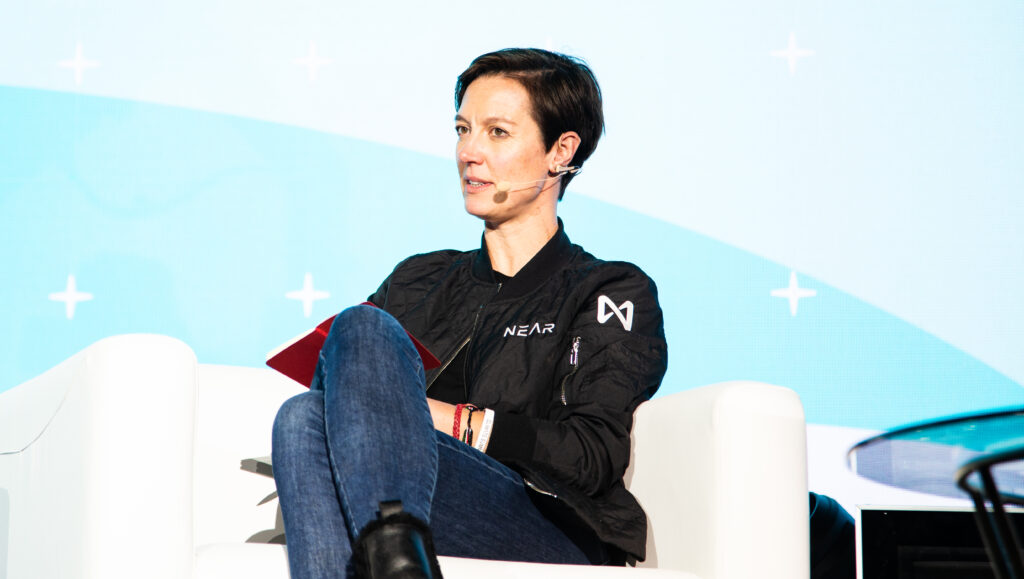
Near Foundation CEO Marieke Flament and Dragonfly Capital’s Haseeb Qureshi also talked about why the future remains bright for Web3 even during the crypto winter. There were also talks from Pagoda’s Pavel Kudinov on the Near data stack and Josh Ford on a fully decentralized Javascript.
Other topics included the building of infrastructure to onboard 1 billion users on Near, NFT infrastructure, a “DeFi survival kit” for the bear market, and the regulatory landscape in Web3.
Near speakers at ETHDenver
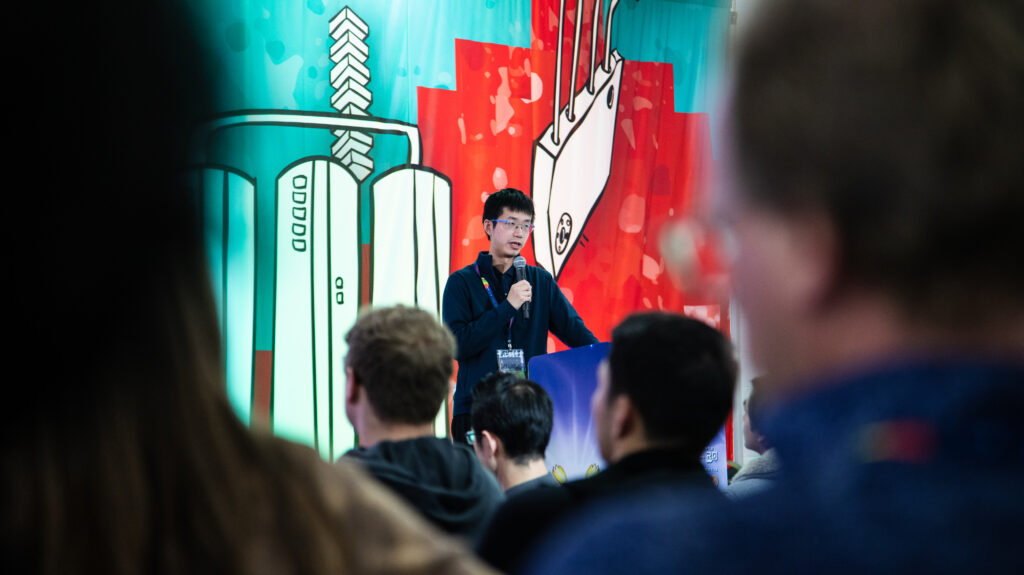
A number of speakers represented the Near ecosystem at ETHDenver talks. Topics included the Blockchain Operating System, sustainability, UX design, and more.
Aurora Labs’ Alex Shevchenko kicked things off with a presentation on Web3 infrastructure and scalability — specifically, how not to hack everything up in creating bridges. Alex also gave another talk on next generation user experience. Near Foundation CEO Marieke Flament delivered a talk on the three pillars of Web3 sustainability, while Proximity Labs’ Kendall Cole explored how Web3 can win in the DeFi battle against app stores.
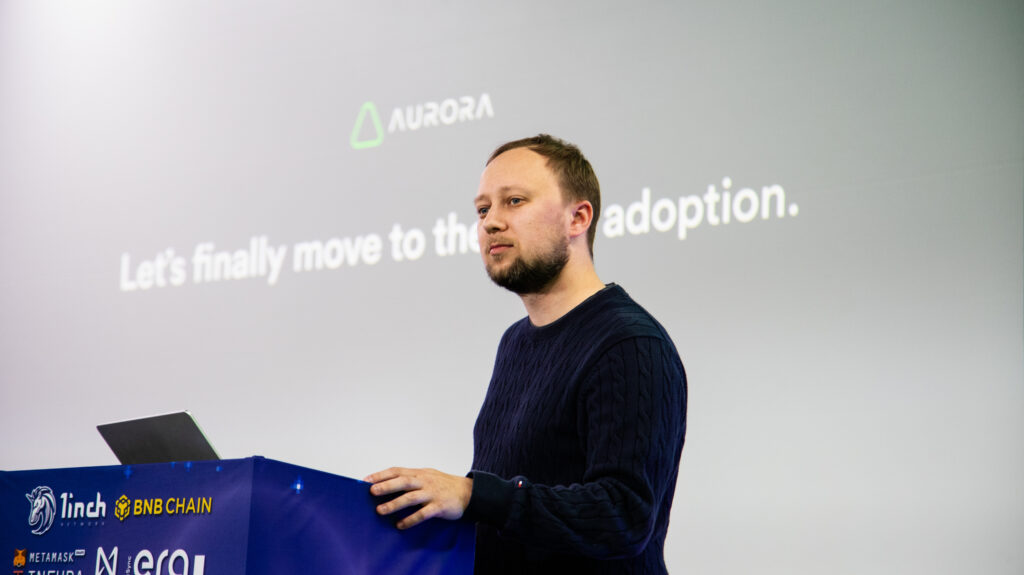
In separate talks, Illia Polosukhin and Pagoda’s Bowen Wang spoke to the ETHDenver audience about the Blockchain Operating System. While Bowen mapped out Near’s vision for Layer 1 Infrastructure, Illia talked about reinventing Web3 development with decentralized frontends and social networking.
Near Announcements
While the Near is the Blockchain Operating System announcement was the talk of ETHDenver, there were plenty of other announcements. Find the full run-down of Near ecosystem announcements here.
In other news, the Near ecosystem had two wins at ETHVC’s Startup Demo Day during ETHDenver — Niche Protocol, a Web3 social media platform, and Kino, a film financing platform.
The post Near at ETHDenver: the Blockchain Operating System, Near Day, and More appeared first on NEAR Protocol.
]]>The post Near Announces the Blockchain Operating System appeared first on NEAR Protocol.
]]>The Blockchain Operating System will make Near the entry point for the Open Web, for users and developers alike. And it will make both Web3 and Web2 easier than ever to access and navigate.
Becoming more than just a blockchain
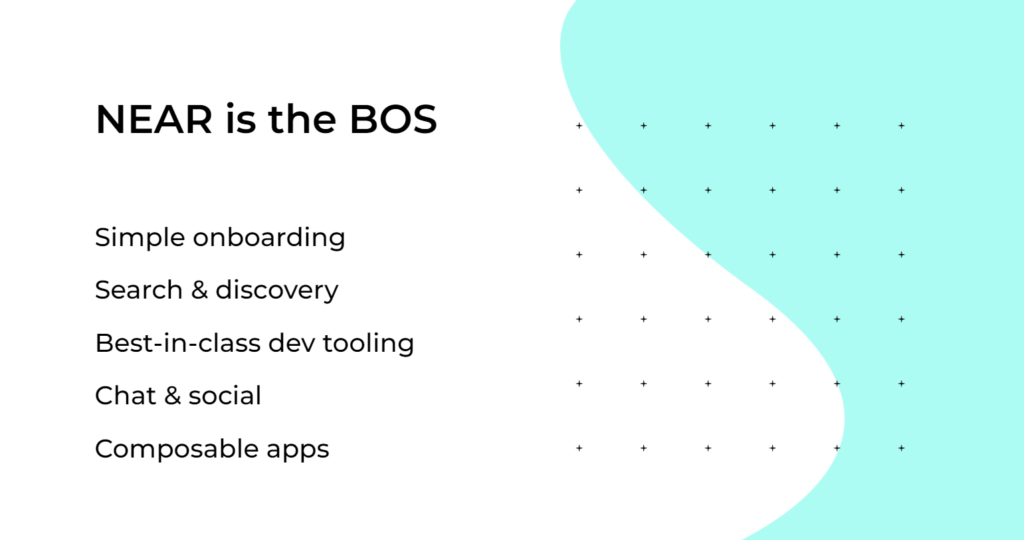
Since inception, Near’s mission has been to onboard 1 billion users to the Open Web. The first step in the journey was to focus on building a best in class L1 blockchain that was easy to build on and easy to use.
Near was designed to be simple, with a flexible account model and human readable accounts — any name a user wants instead of a string of letters and numbers. And with Near’s Nightshade sharding approach, the Near blockchain was designed to be infinitely scalable and secure. At the same time, Near concentrated on building out tooling to support builders developing on the protocol, including the JavaScript SDK that now gives 15 million developers access to building on Near.
This has created and sustained a thriving Near ecosystem with more than 23 million accounts and over a thousand project building, but these were only the first steps toward delivering the vision of Web3 to a mainstream audience.
Now, Near is building up the Web3 stack to integrate experiences from across the open web and streamline the discovery and onboarding experience for users and developers alike.
Enter Near: the Blockchain Operating System
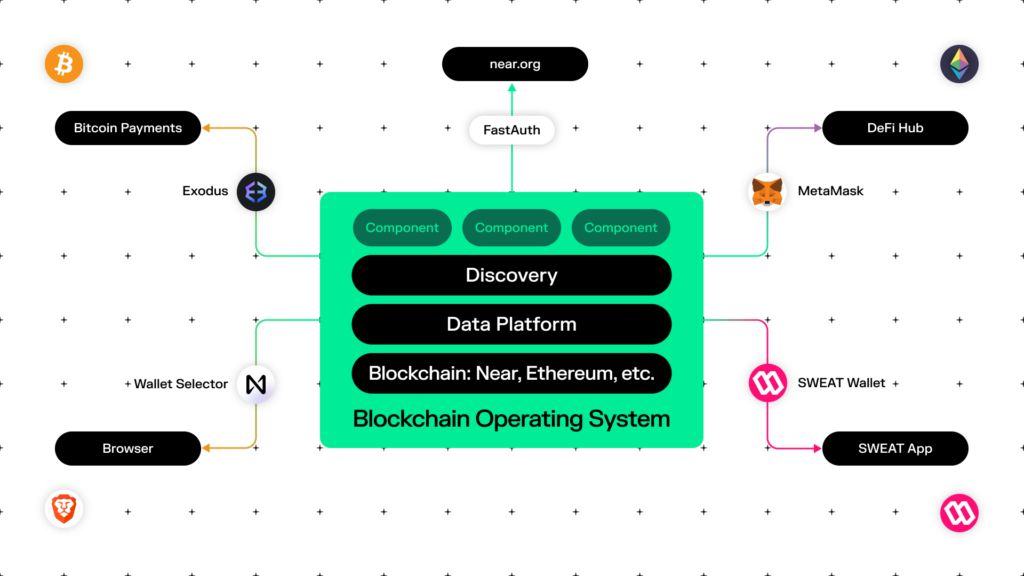
Today, Near is launching near.org — a composable frontend for Web3. It will allow end users to easily and frictionlessly discover all of Web3’s possibilities in one seamless experience. It will also empower developers to create and code interfaces in a single environment with the ability to fork a host of components to build apps faster, and more efficiently than ever before.
Anyone in the Open Web ecosystem can create their own frontends (i.e., their own versions of near.org), compatible with the blockchain of their choice. This means that builders from any ecosystem can create components in just a few lines of code, and take advantage of fast onboarding to help make new and custom Web3 experiences.
This is an industry first. With the addition of composable frontends to the tech stack, Near now becomes the Blockchain Operating System, allowing seamless, one-time onboarding and removing friction points like making accounts for every experience, while supercharging development from a collection of over 1,800 components.
Near.org is the first step in Near’s Blockchain Operating System journey. It’s the Alpha version, where builders can see the frontend come to life.
Try it out at near.org to experience the world’s first Blockchain Operating System — a revolutionary moment in Web3. If you’re a developer, see how easy it is to fork components and create new experiences. If you’re an end user, see how easy it is to explore Web3 experiences, social, and news all in one place.
The Blockchain Operating System is Near and it’s here. #NearistheBOS
The post Near Announces the Blockchain Operating System appeared first on NEAR Protocol.
]]>